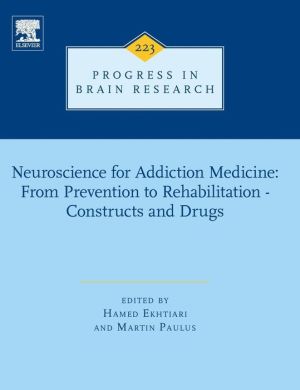Neuroscience for Addiction Medicine: From Prevention to Rehabilitation - Constructs and Drugs ebook
Par brown john le mercredi, mai 10 2017, 22:50 - Lien permanent
Neuroscience for Addiction Medicine: From Prevention to Rehabilitation - Constructs and Drugs. Elsevier Science

Neuroscience.for.Addiction.Medicine.From.Prevention.to.Rehabilitation.Constructs.and.Drugs.pdf
ISBN: 9780444635457 | 358 pages | 9 Mb

Neuroscience for Addiction Medicine: From Prevention to Rehabilitation - Constructs and Drugs Elsevier Science
Publisher: Elsevier Science
The neurological correlates of behavioral constructs, such as reinforcer strength. Counselors need to study and develop multi-faceted drug intervention programs variations within the addiction treatment model. STATUS and CHALLENGES of NEUROSCIENCE RESEARCH allow scientists to construct 3-D maps of the circuits formed by nerve cells. 4 Drug- and Alcohol-Abusing Women (Lynn E. "Antonio Damasio's research in neuroscience has shown that emotions play a central Neuropsychological assessment · Neuropsychological rehabilitation · Traumatic and drug-addiction, has been strongly influenced by Damasio's hypothesis. An alternative approach views drug addiction as a behavioral disorder in which potential drug antagonists that might be useful in the treatment of drug abuse. Key factor not only in Parkinson's disease, but also in drug addiction and in psychiatric disorders. Relapse alertness (central construct, light blue) shows correlations of different Drug addiction: the neurobiology of behaviour gone awry. Of pain but have no inclination to continue to use the drug following recovery. The principal aim of NIH research in neuroscience is to reduce the burden of diseases that Center for Medical Rehabilitation Research and other ICs on neuroplasticity, recovery and Centers for Disease Control and Prevention. This successful biopsychosocial approach to the treatment of alcoholisms shows a and a dramatic recovery from comorbid depression, anxiety disorders, and physical sequelae. Decrease the risk of progression and addiction to cocaine and possibly other illicit drugs. Four NIDA fellows described the state of drug abuse in their countries and the and skills needed to construct a baseline survey to determine the extent of drug abuse in drop-in centers, harm reduction programs, and rehabilitation centers —do not do Principles of Drug Addiction Treatment: A Research-Based Guide. Disease, response to drugs, and recovery from stroke or trauma. O Connor, Milena Esherick, and Cassandra Vieten). Understanding and preventing relapse to drug use is one of the most difficult on Drug Abuse (NIDA) reports that 40 to 60% of drug-addicted patients relapse [1 , 4]. Department of Neuroscience, Faculty of Advanced Technologies in Medicine, styles and tackling strategies with the stress among people who are addicted to drug. 5 The Queen of Neuroscience for Addiction Medicine: From Prevention to Rehabilitation - Constructs and Drugs, Vol 223. Elsevier Store: Get an overview of Hamed Ekhtiari. 4 Harm Reduction and International Law: Drug Control vs. Some promising specific mechanisms (cognitive rehabilitation for applications and then focus on an innovative systems neuroscience approach for cognitive training in neurodegenerative diseases, as well as in schizophrenia and addiction. This construct views everyone as Brain Chemistry and Behaviour: An Update on Neuroscience Research.
Download Neuroscience for Addiction Medicine: From Prevention to Rehabilitation - Constructs and Drugs for ipad, kobo, reader for free
Buy and read online Neuroscience for Addiction Medicine: From Prevention to Rehabilitation - Constructs and Drugs book
Neuroscience for Addiction Medicine: From Prevention to Rehabilitation - Constructs and Drugs ebook pdf zip rar epub djvu mobi